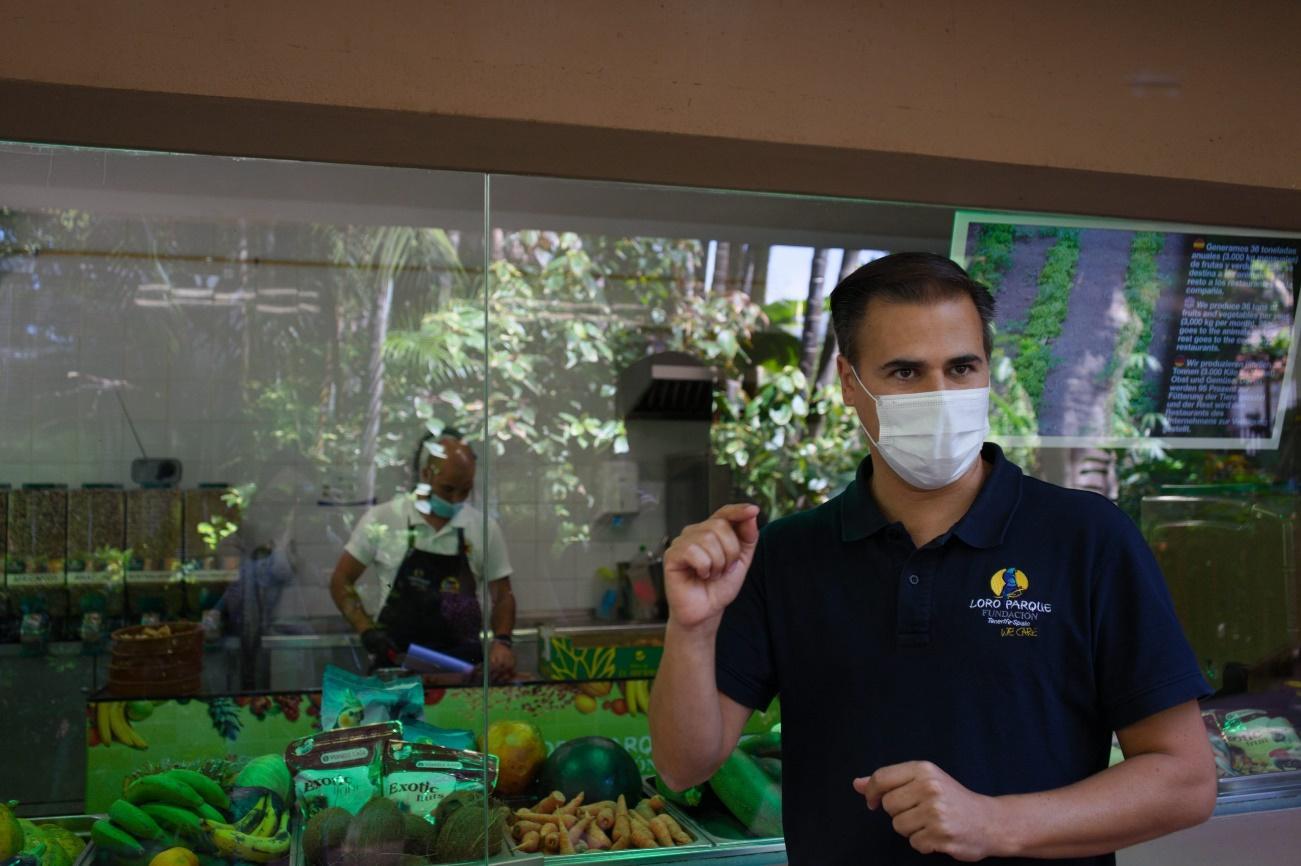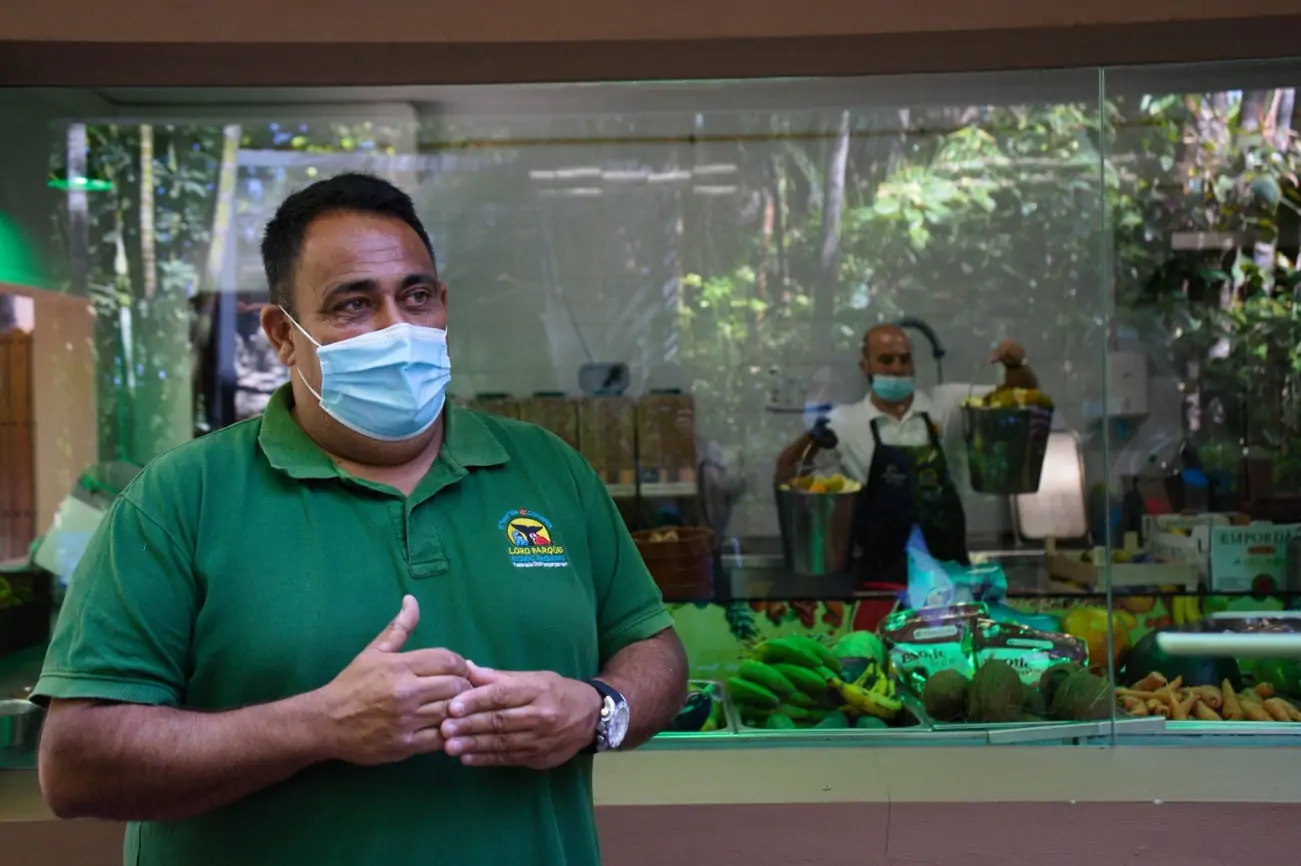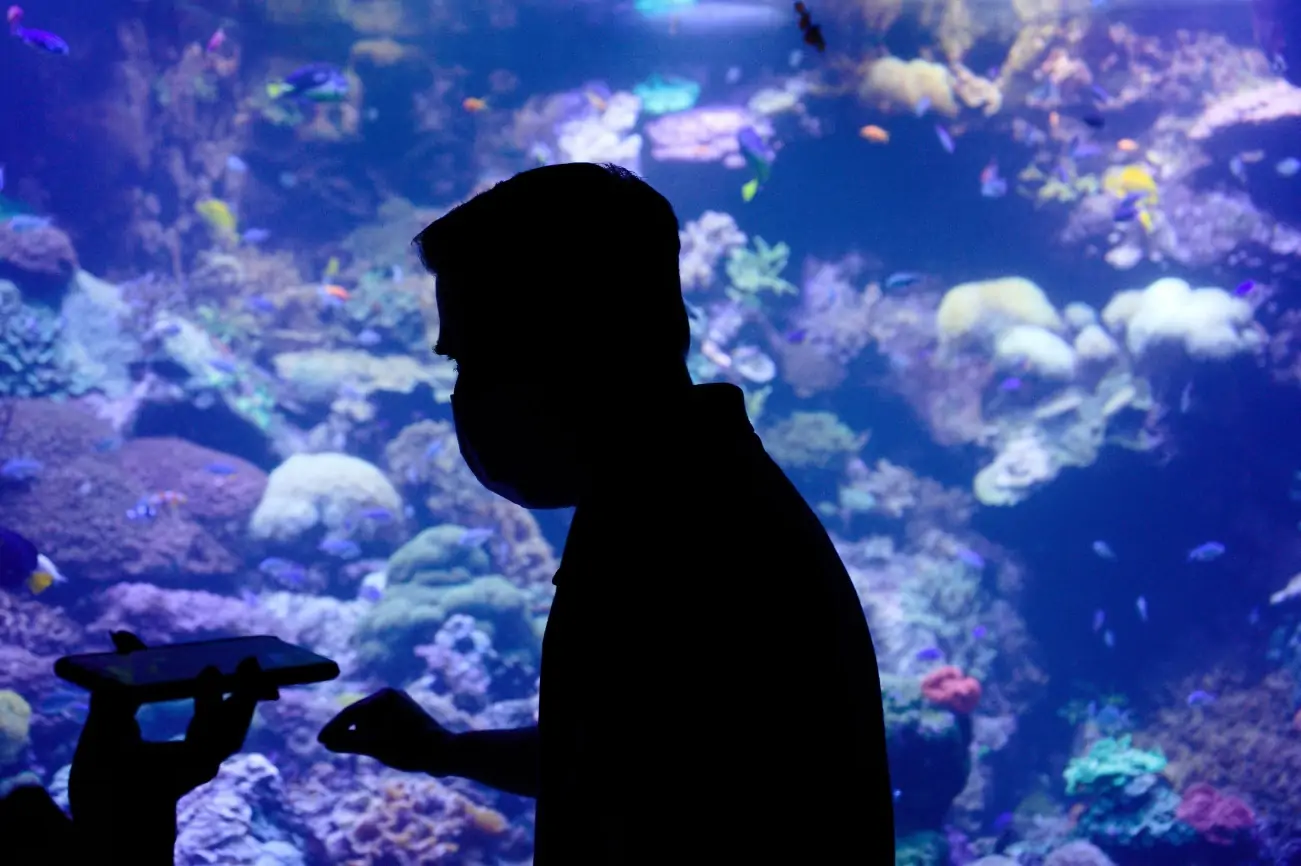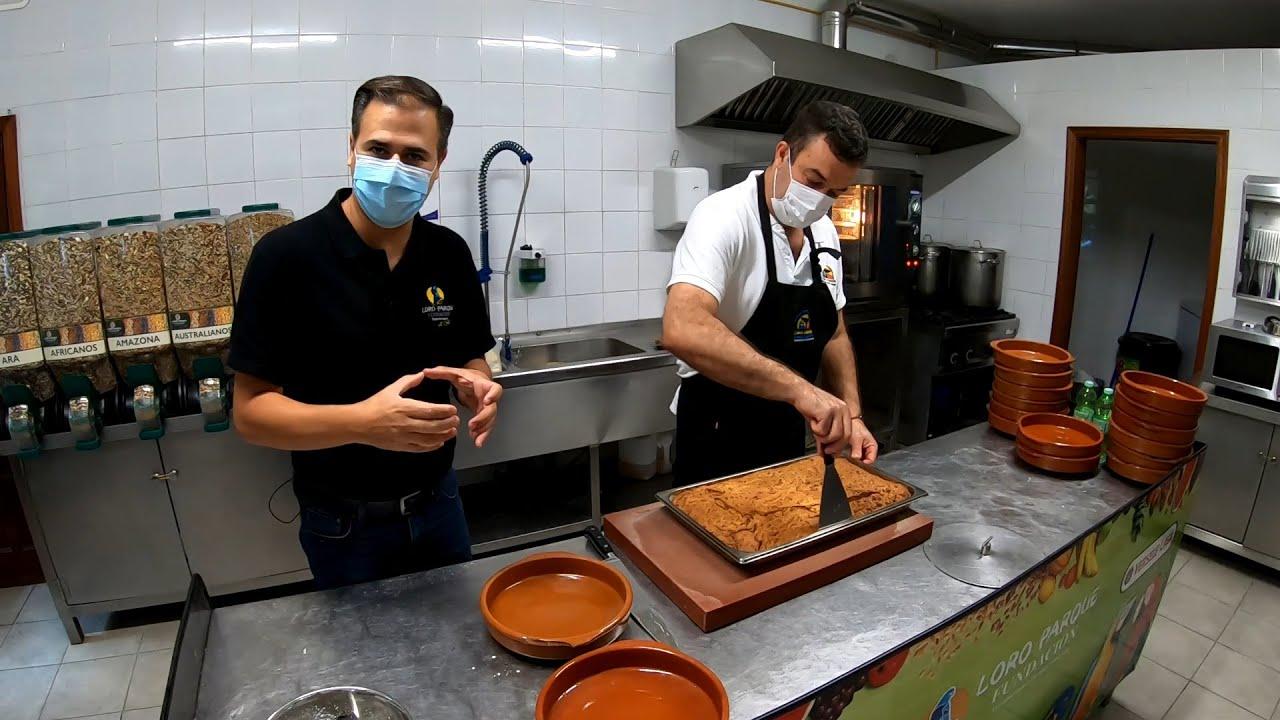Loro Parque is the second most visited attraction on the island of Tenerife, after the Teide National Park. Since it opened its doors in 1972, the park has been deeply committed to the care and preservation of species, both in the facilities of the animal embassy and around the world. In this way, the zoo founded by Wolfgang Kiessling, today president of the Loro Parque Company and Loro Parque Fundación, has become one of the most respected institutions in this field. Together with the Loro Parque Fundación, it currently has the largest and most diverse reserve of parrot species and subspecies in the world, making it the leading international breeding organisation.
For the first time since the creation of the GastroCanarias project, we dedicated one day to animal feed. The team had the opportunity to learn first-hand about the nutrition of the different species of the Loro Parque. For this, we have had the invaluable collaboration of Rafael Zamora Padrón, scientific director of Loro Parque Fundación (founded in 1994) and prestigious biologist specialised in zoology. In addition, Nicolás Perdomo Linares, Loro Parque‘s agricultural engineer and the technician responsible for the company’s plantations, provided us with more information about the organic farming from which they obtain all their products.
First of all, the priority at the park has always been that the food should be organic. Nicolás Perdomo explains that they reached a consensus that everything has to be as natural as possible for the animals. “This has to do with security measures, so we make sure that the products we offer to the animals in the park do not contain chemicals or bacteria that could be detrimental to the animal’s health and quality of life,” says the engineer.
Another very important aspect is that they do not use pesticides, but insects that control possible pests. The farms are registered with the ICCA (Canary Islands Institute of Agri-food Quality) and every year an inspection is carried out to check the water used to grow the crops and the nutrients given to the plants. Perdomo says that it has taken two years to completely clean the farm from previous toxicities.

The products consumed by the animals are the same as those consumed by humans. In the renowned restaurant Brunelli’s Steakhouse, or in the prestigious Hotel Botánico & The Oriental Spa Garden, as well as in the aquarium Poema del Mar (in Gran Canaria) or the Siam Park, in the south of Tenerife, all belonging to the same property of Loro Parque Company, they prepare and cook everything with the vegetables and fruit that they grow themselves in the company’s own organic farms and gardens. “The quality of the products for our animals and also for our customers is absolutely essential,” says Nicolás Perdomo.
In the garden they grow everything from lettuce, endive and aubergines to sugar cane, tamarind, lychee and tropical fruits, and more. In the park they make sure to have the greatest variety of fruits and vegetables available so that the animals do not always get the same products, and get a variety of vitamins, as well as the opportunity to explore different flavours.
The fruit and vegetables are not frozen, they are picked every Monday and Thursday. Some of these products have a second use, as they are used for environmental enrichment. This translates into a real challenge: to make the habitat in which the animals are kept as similar as possible to their habitat in nature.
Loro Parque’s policy focuses on a preventive system for the health of the animals. “It is very important to have a good veterinary team, but it is just as important to have a system that avoids vulnerable health situations as much as possible,” says the park’s scientific director and biologist.
On the other hand, the feeding times are different, but first thing in the morning all the animals in the park receive their food. From 6:00 – 7:00 a.m. the workers prepare the food for each species.
Birds
The longevity of parrots is good, as they easily live for more than twenty years. “To maintain that longevity, one of the successes is that they have foods that are full of antioxidants and varied,” says Zamora. The difference that exists with wild nature is that these animals have to remember which tree is ripe, so each year they have to take that into account to find food according to seasonality.
It is important to remember that each species of parrot eats differently. Loro Parque Fundación has the largest genetic reserve of parrots on planet earth. “The tropical and subtropical climate of Tenerife allows us to keep any parrot in the world under the best conditions,” argues Rafael Zamora. The quality of the fruit and vegetables must also be taken into account, as it must be guaranteed that the food they eat matches that of the nature from where the birds come from.
The great team of professionals at Loro Parque has to adapt to each type of animal. They prepare fruit salads that vary depending on the day, as it is important that they are not always the same. “We combine three different types of fruit each time so that the animals have variety. The most important thing for them is change,” says the biologist.
There is a protocol that constantly changes and says how it is to be presented and what is to be presented. There is a planning of what is given to the animals. The amount of food is also important, the parrots are fed twice, sometimes up to four times, and their water is also changed. At this point it is essential for the keepers to bear in mind that the parrots do not drink from stagnant water, they always look for the freshest source. For this reason, they have installed micro-sprinkler showers in more than 1,600 aviaries, which produce artificial rain and thus stimulate environmental enrichment.
In addition, a sponge cake is prepared that is essential for the parrots, as it is made with natural flours, both wheat and corn, and dates, sultanas, prunes and minerals added, which they need. “They don’t eat it every day, so they have an element of surprise,” Zamora explains.

The nutrition the animals have in the park is more balanced than they could have in certain circumstances in nature. In the wild, they face several problems, including finding food. At certain times, they have to travel thousands of kilometres to feed themselves and often have to forage not only for themselves but also for their offspring. This can lead to stress, which, as Rafael Zamora rightly states, is a natural stress, but forces them to be constantly alert: “They have a very high energy expenditure and that is why many animals have a greater longevity in controlled environments”.
Today, they grow all the food the animals need, even those live foods they used to get from other sources. It is a process that they have been implementing step by step and which is key to the health of the animals in the park.
Rafael Zamora tells us that years ago they used to buy seeds from different companies and then made the appropriate mixtures for each species of parrot. Later, they discovered Versele-Laga, the world’s “seed kings”. This Belgian company has become one of the biggest sponsors of the Loro Parque Fundación. “They themselves were surprised at how healthy the parrots were and wanted to know what formula we were using,” says the scientific director. So, they came to an agreement in which they exchanged quality and knowledge, and produced something good for the world.
Aquatic Animals
To feed the fish, there is an access from the top, bridges from which the aquarists feed them. The corals, which are also animals, have to be fed individually. To do this, a slurry is prepared and dispensed with various utensils that allow you to get close to each animal.
Aquarists have to be very meticulous and check that they all eat their fair share, as there are some fish that eat at the surface, others in the middle and others at the bottom. On the surface it looks like they all eat because they enjoy it, but it is very difficult to control. In the case of other animals such as otters, it is easier to control because there are few of them and you can see which ones eat and which ones do not. When there is one that is more isolated, you wait until the others are eating to assign it its ration. In this case, fish, preferably freshwater fish such as trout.
The fish is checked and the histamine, which is the component that could cause allergies in animals, is tested. The product is delivered directly and frozen, so it arrives as if it is freshly caught: “The quality of the fish has to be the best, because the health of the animal depends on it,” Zamora stresses.

Mammals
Mammals, for example gorillas, need a variety of fruit and vitamin C levels must always be maintained. In the kitchens they store a blossom honey, which must not contain any toxic substances, and place it inside trunks so that they can find it themselves. With the palm leaves that the keepers give them in the mornings, they break the branches and make their own spoon with which they extract the honey. “We want the animals to learn how hard it is to get their food and to be able to handle themselves in situations like this where they have to use their intelligence and dexterity”, says Zamora.
To feed species as large as these, there is a safety protocol in which food is provided from a controlled access, with security systems and double doors. In addition, the keeper must never go alone, there will always be two people. In the case of reptiles, such as the caiman, it is the same. In this case, they feed on white meat such as chicken because it is healthier and facilitates digestion, which is very slow in these species.
Loro Parque must guarantee that the food that an animal usually eats in its natural habitat will be available in the enriched space for it. In the case of the red pandas, which eat more than 400 grams of bamboo a day, they have cultivated up to eight different varieties. “This species only eats fresh bamboo shoots, so you have to offer it to them every day,” says Rafael. He also stresses that they should eat as naturally as possible, in the sense that they break off the bamboo themselves and remove the shoots, just as they would do in the wild.
The animal’s biology matches its nutrition
The professionals are also looking for the element of surprise when feeding meat, so that the animals do not get tired of it every day. It should be noted that the most important thing here is the presentation. In many cases, they hide the meat so that the animals can use their sense of smell and carry out their daily physical activity.
In addition, they change the parts of the meat, offering pieces of thigh, loin, neck… and, not least, the blood. “In summer we make an ice cube with meat in it and they have to wait for it to melt before they can eat it. In this way, they are entertained and kept active with this stimulus. We don’t put any live animals in it because there is no need. We give the animals a health-controlled quality as if it would be for humans”, stresses the scientific director of Loro Parque Fundación.
In the gestation period, the females, like humans, begin to look for food that the body needs. “Animals that previously did not want to eat red peppers for a long time suddenly demand it. The keeper therefore has to be attentive to give the animal the appropriate food for its needs,” explains Rafael Zamora.
Finally, it is important to know that no food is ever fed in the park without prior consultation with the team. For example, Zamora commented that he was asked to introduce blackberries into the gorillas’ diet, but too much of this food can cause stomach problems. Therefore, it was recommended that the branches are used but without fruits.
After all this information, it becomes clear that the feeding of the animals is, one could say, very varied and specific. In the parrot park, as in human life, the best possible nutrition is paramount, as it is the most important basis of life and essential for good health.


